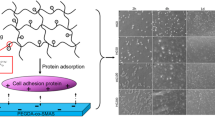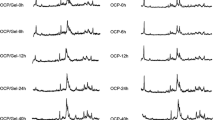Abstract
Bone morphogenetic protein 2 (BMP-2)-functionalized poly(l-lactide-co-ε-caprolactone) (PLCL) porous scaffolds have shown promising results in bone tissue regeneration studies. It is believed that even better results are achieved by hierarchical porous scaffolds and a designed sequential release of growth factors. We therefore synthesized (l-lactide-co-glycolide)-g-poly(ethylene glycol) (PLGA-g-PEG) oligomers which could be injected into PLCL porous scaffolds. They were synthesized by ring-opening polymerization and carefully characterized by nuclear magnetic resonance spectroscopy (NMR), matrix-assisted laser desorption ionization time-of-flight mass spectrometry (MALDI-TOF-MS), and size exclusion chromatography (SEC). The sol–gel transition temperature, pH, and functional life were determined and correlated with the molecular structure of PLGA-g-PEG. We found that low molecular weight PLGA-g-PEG was obtained and poly(l-lactide-co-glycolide-co-poly(ethylene glycol) methyl ether) (PLGA-MPEG) appeared to contribute to gelation. It was possible to design a system that formed a hydrogel within 1 min at 37 °C with a pH between 6 and 7 and with a functional life of around 1 month. These low molecular weight thermosensitive PLGA-g-PEG oligomers, which can be injected into PLCL scaffolds, appear promising for bone tissue engineering applications.













Similar content being viewed by others
References
Finne A, Albertsson A-C (2004) New functionalized polyesters to achieve controlled architectures. J Polym Sci Part A Polym Chem 42:444–452. doi:10.1002/pola.10805
Tyson T, Målberg S, Wåtz V et al (2011) Functional and highly porous scaffolds for biomedical applications. Macromol Biosci 11:1432–1442. doi:10.1002/mabi.201100166
Idris SB, Arvidson K, Plikk P et al (2010) Polyester copolymer scaffolds enhance expression of bone markers in osteoblast-like cells. J Biomed Mater Res A 94:631–639. doi:10.1002/jbm.a.32726
Dånmark S, Finne-Wistrand A, Wendel M et al (2010) Osteogenic differentiation by rat bone marrow stromal cells on customized biodegradable polymer scaffolds. J Bioact Compat Polym 25:207–223. doi:10.1177/0883911509358812
Hoffman AS (2002) Hydrogels for biomedical applications. Adv Drug Deliv Rev 54:3–12. doi:10.1016/S0169-409X(01)00239-3
Slaughter BV, Khurshid SS, Fisher OZ et al (2009) Hydrogels in regenerative medicine. Adv Mater 21:3307–3329. doi:10.1002/adma.200802106
Ruel-Gariépy E, Leroux J-C (2004) In situ-forming hydrogels—review of temperature-sensitive systems. Eur J Pharm Biopharm 58:409–426. doi:10.1016/j.ejpb.2004.03.019
Chen G, Hoffman AS (1995) Graft copolymers that exhibit temperature-induced phase transitions over a wide range of pH. Nature 373:49–52. doi:10.1038/373049a0
Malmsten M, Lindman B (1992) Self-assembly in aqueous block copolymer solutions. Macromolecules 25:5440–5445. doi:10.1021/ma00046a049
Jeong B, Bae YH, Lee DS, Kim SW (1997) Biodegradable block copolymers as injectable drug-delivery systems. Nature 388:860–862
Jeong B, Bae YH, Kim SW (1999) Thermoreversible gelation of PEG-PLGA-PEG triblock copolymer aqueous solutions. Macromolecules 32:7064–7069. doi:10.1021/ma9908999
Jeong B, Wang L-Q, Gutowska A (2001) Biodegradable thermoreversible gelling PLGA-g-PEG copolymers. Chem Commun 2001:1516–1517
Chung Y-M, Simmons KL, Gutowska A, Jeong B (2002) Sol-gel transition temperature of PLGA-g-PEG aqueous solutions. Biomacromolecules 3:511–516. doi:10.1021/bm0156431
Jeong B, Lee KM, Gutowska A, An YH (2002) Thermogelling biodegradable copolymer aqueous solutions for injectable protein delivery and tissue engineering. Biomacromolecules 3:865–868. doi:10.1021/bm025536m
Cho K, Kim C, Lee J, Park JK (1999) Synthesis and characterization of poly(ethylene glycol) grafted poly(l-lactide). Macromol Rapid Commun 20:598–601
Gilding DK, Reed AM (1979) Biodegradable polymers for use in surgery—polyglycolic/poly(actic acid) homo- and copolymers: 1. Polymer (Guildf) 20:1459–1464. doi:10.1016/0032-3861(79)90009-0
Jeong B, Windisch CF, Park MJ et al (2003) Phase transition of the PLGA-g-PEG copolymer aqueous solutions. J Phys Chem B 107:10032–10039. doi:10.1021/jp027339n
Lin G, Cosimbescu L, Karin NJ, Tarasevich BJ (2012) Injectable and thermosensitive PLGA-g-PEG hydrogels containing hydroxyapatite: preparation, characterization and in vitro release behavior. Biomed Mater 7:024107. doi:10.1088/1748-6041/7/2/024107
Dunn AS, Campbell PG, Marra KG (2001) The influence of polymer blend composition on the degradation of polymer/hydroxyapatite biomaterials. J Mater Sci Mater Med 12:673–677
Dånmark S, Finne-Wistrand A, Schander K et al (2011) In vitro and in vivo degradation profile of aliphatic polyesters subjected to electron beam sterilization. Acta Biomater 7:2035–2046
Zhou S, Zheng X, Yu X et al (2007) Hydrogen bonding interaction of poly(d,l-lactide)/hydroxyapatite nanocomposites. Chem Mater 19:247–253. doi:10.1021/cm0619398
Acknowledgments
The authors gratefully acknowledge the financial support from KTH, Royal Institute of Technology.
Author information
Authors and Affiliations
Corresponding author
Electronic supplementary material
Below is the link to the electronic supplementary material.
ESM 1
(PDF 447 kb)
Rights and permissions
About this article
Cite this article
Fagerland, J., Finne-Wistrand, A. Mapping the synthesis and the impact of low molecular weight PLGA-g-PEG on sol–gel properties to design hierarchical porous scaffolds. J Polym Res 21, 337 (2014). https://doi.org/10.1007/s10965-013-0337-8
Received:
Accepted:
Published:
DOI: https://doi.org/10.1007/s10965-013-0337-8




